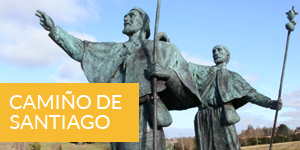- Accede I
- Regístrate I
- carrito
Presentación
Bienvenido a Santiago de Compostela. Desde esta puerta virtual se abre para usted la capital de la Comunidad Autónoma de Galicia; una ciudad declarada Patrimonio de la Humanidad por la UNESCO gracias a su belleza monumental, extraordinaria conservación y por ser meta de una milenaria ruta de peregrinación: el Camino de Santiago, que desde el siglo IX transformó este paraje del finis terrae en punto de encuentro de la fe y el pensamiento del mundo occidental.
Santiago de Compostela es una aparición de piedra anidada entre los verdes bosques del Noroeste español y las cercanas rías gallegas. Comenzó por ser lugar de paso junto a una vía romana, pero el descubrimiento de la tumba del Apóstol Santiago a principios del siglo IX hizo surgir un lugar de culto en los confines de una península a la sazón dominada por la invasión musulmana. Desde entonces toda Europa se echó a andar hacia Santiago, ciudad santa de la cristiandad en la que les esperaba la gracia de la absolución plenaria. Allí emergió una catedral románica a la que el transcurrir de los siglos quiso añadir la sobriedad del Renacimiento y la majestuosidad de un Barroco que terminó por trazar la imagen monumental de la urbe, hecha del granito de sus monasterios, sus hospitales de peregrinos, sus numerosas iglesias, sus casas señoriales y unas plazas en las que el tiempo escogió quedarse detenido.
La tradición continúa viva y la espiritualidad del continente sigue mirando a Compostela, como demostraron los últimos Años Santos y como probará sin duda la cita jubilar de 2027. Para los visitantes guarda la ciudad sus tesoros, que se exhiben en 16 museos, y la sorprendente riqueza de su arquitectura contemporánea, firmada por Eisenman, Hejduk o Siza, alrededor de la cual se extiende la más importante dotación de parques y jardines de toda Galicia.
En este escenario brotan con fuerza las manifestaciones culturales –desde las fiestas populares hasta los festivales anuales de música, cine y teatro, exposiciones permanentes e itinerantes– de la mano de una iniciativa pública y privada liderada por la cinco veces centenaria Universidad de Santiago, cuyas aulas añaden 23 mil estudiantes a una población estable de cerca de 100 mil compostelanos.
Durante todo el año, además, se suman a ellos varios millones de visitantes. Los que llegan exhaustos por devoción; los que acuden llamados por el prodigio monumental o los que eligen Compostela como lugar para sus eventos profesionales: todos acaban integrándose en la celebración permanente que es la vida en la ciudad, especialmente durante las Fiestas del Apóstol, declaradas de Interés Turístico Internacional. Para su bienestar despliega Santiago una red de alojamientos que supera las 10.700 plazas –3.500 de ellas en hoteles–, además de 5.000 plazas disponibles en infraestructuras específicas para reuniones y congresos y una oferta gastronómica capaz de satisfacer todos los paladares y todos los bolsillos. No en vano somos desde hace más de mil años una tierra de acogida universal, un punto de llegada y encuentro nacido para el ejercicio cotidiano de la hospitalidad.












